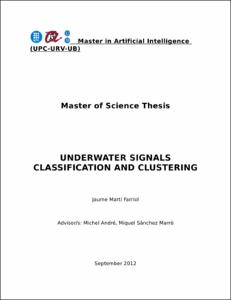Mostra el registre d'ítem simple
Underwater signals classification and clustering
| dc.contributor | André, Michel |
| dc.contributor | Sànchez-Marrè, Miquel |
| dc.contributor.author | Martí Farriol, Jaume |
| dc.date.accessioned | 2012-10-31T15:08:26Z |
| dc.date.available | 2012-10-31T15:08:26Z |
| dc.date.issued | 2012-09 |
| dc.identifier.uri | http://hdl.handle.net/2099.1/16446 |
| dc.description | The presence of noise in the oceans has been growing in the recent years due to the increasing levels of human activity on the seas. Those activities include the off shore industry, petrol industry and transport industries. This noise contamination damages the marine ecosystem. In order to plan human activities on the seas in such a way that they produce the minimum alteration to the marine ecosystem it is very beneficial to be able to understand the relation between anthropogenic and natural process. One the practical side, this thesis could be the starting point for future technologies that could help plan human activities in such a way that mitigate the most the impact they produce on the ocean environment. A part from protection of the ocean fauna from hearing loss and damage to their sonars this project could also help researchers to monitor marine fauna. (...) The aim of this thesis is the classifi cation in real time of underwater frequency modulated acoustic signals into predefi ned groups. The signals are constrained into those being frequency modulated because the automatic classi cation of impulsive sounds has already been subject of considerable study. Apart from classi cation, clustering of tonal sounds is also a topic of this thesis. The kind of acoustic emissions that can be found on the underwater environment in the seas and oceans of the planet come from 3 broad categories, those categories are biological sources, i.e. dolphins, baleens, etc; anthropogenic sources, i.e. ship motors, ship sonars, etc; and natural phenomena like earthquakes and rain. Of those categories, those that produce frequency modulated tonal sounds are marine mammals and some ship sonars. The underwater signals studied in this thesis are obtained from deep sea platforms and o ffshore moored stations, and are transmitted wirelessly or though a cord to coastal computer centers, where the signals are analyzed. |
| dc.description.abstract | This thesis deals with the problem of classification and clustering of tonal sounds. Tonal sounds are a class of sounds that are localized in frequency and extend over a time with frequency modulation. To achieve those goals, the problem of tonal extraction is also studied. |
| dc.language.iso | eng |
| dc.publisher | Universitat Politècnica de Catalunya |
| dc.rights | Attribution-NonCommercial-NoDerivs 3.0 Spain |
| dc.rights.uri | http://creativecommons.org/licenses/by-nc-nd/3.0/es/ |
| dc.subject | Àrees temàtiques de la UPC::Informàtica::Intel·ligència artificial::Representació del coneixement |
| dc.subject | Àrees temàtiques de la UPC::Matemàtiques i estadística::Estadística matemàtica |
| dc.subject | Àrees temàtiques de la UPC::Enginyeria de la telecomunicació::Processament del senyal::Processament de la parla i del senyal acústic |
| dc.subject.lcsh | Underwater acoustics |
| dc.subject.lcsh | Data--Classification |
| dc.subject.lcsh | Cluster analysis |
| dc.title | Underwater signals classification and clustering |
| dc.type | Master thesis |
| dc.subject.lemac | Acústica submarina |
| dc.subject.lemac | Dades--Classificació |
| dc.subject.lemac | Anàlisi de conglomerats |
| dc.rights.access | Open Access |
| dc.audience.educationlevel | Màster |
| dc.audience.mediator | Facultat d'Informàtica de Barcelona |
| dc.audience.degree | MÀSTER UNIVERSITARI EN INTEL·LIGÈNCIA ARTIFICIAL (Pla 2009) |


